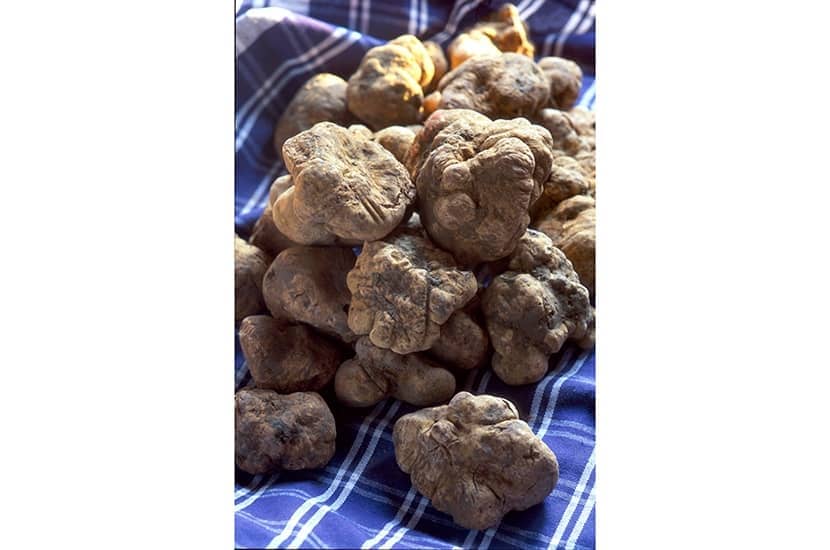Truffles smell of sex. Even if we can’t quite say what we mean by ‘smell’ or ‘sex’ in this sentence, the much sought-after underground fungi emit something analogous to the pheromones that subconsciously attract us to other human beings. On the conscious level, these members of the family Tuberaceae release aromas ranging from floral to garlic to petrol to old socks, which pigs and dogs also find appealing. It can be faked, too. Most so-called truffle oil gets its scent from the chemical 2,4-Dithiapentane.
In Truffle Hound, his pacy travelogue-cum-foodie manual, Rowan Jacobsen deals with about a dozen species of truffles (or other near-truffle fungi). In practice, there are only two that command our attention: the Italian white Alba truffle, Tuber magnatum, and the one Jacobsen calls the black winter truffle, Tuber melanosporum, often called the Périgord truffle. The more prized white truffle fetches mighty prices and is used parsimoniously, by shaving it over cooked food with a dedicated utensil. Its outrageous fragrance and slight crunch are its USP. It’s never cooked, but its whiff is enhanced by the warmth of the pasta or egg over which it is shaved. The more common, but still rare, black winter truffle is sometimes cooked in foie gras, inserted under the skin of a chicken, or baked whole in a pastry covering. I can testify that it is the supreme hang-over cure. Once, in Lyon, where my wife and I had had one too many three-star meals, a sympa chef served us only a glass of champagne, a whole raw black truffle, a sharp knife and a salt cellar.
The folklore associated with truffles — that they are created by lightning, so thunderstorms in August and September augur well for the autumn; that they always appear in exactly the same spot, growing on or between the roots of oak or hazelnut trees, at exactly the same day every year in the lunar calendar — serves a purpose: to disguise the fact, writes Jacobsen, that ‘95 per cent of the world’s black winter truffle crop is farmed’. Truffles, especially the white ones, are still sold in ersatz black markets, often car parks, where the vendor opens the boot of his car and reveals the pongy goods, along with some very precise scales. This helps to maintain the pretence that they are non-taxable windfall, hunted by dogs (pigs haven’t been used for generations, as they tend to eat the truffle before the hunter can get to it), rather than cultivated commodities on which VAT should be levied.
In the early 1980s Jane and Geoffrey Grigson and I went to Alba for the Fair of St Martin, which celebrates the truffle found there (and in other lucky corners of Europe, east to the Black Sea), and is still a tourist attraction. There the Morra family had a perfectly legal monopoly (though not a monopoly in law) on dealings in white truffles because they were said to possess the secret of preserving them tinned in brine (they sold the brine to the canning giant Urbani for a percentage of the turn-over). The old Signor Morra, whom we met, was authorised to issue VAT invoices; the truffle hunters would sell him a fraction of their haul to satisfy the VAT inspector that at least some of their business was kosher. Morra, of course, determined the price. The finder could accept, and get the coveted invoice, or take his chances at the Alba Saturday market or on the black market.
Signor Morra was apoplectic when the Grigsons and I insisted on meeting Giusto Giovannetti, professor of mycology at the University of Turin, and Francesco Tagliaferro, whose firm mycorrhised the roots of young trees, infecting them with the spores that will give rise to mycelium when the tree is planted and, within five years or so, the fruiting body that is the truffle. Our informants said that even T. magnatum was being farmed this way.
Jacobsen is kind — too kind for my taste — about what he calls the black summer and black autumn truffles, both of which are now classified as Tuber aestivum. Because the autumn variety ‘come later in the season and build a lot more aromatics’ and are found all over Europe and into Iran and Turkey and are also cultivated, he finds their fragrance ‘beautiful, delicate, floral; boiled corn and frying hazelnuts’. Maybe. I don’t think I’ve ever sampled a specimen. But the summer truffle is a snare and a deception. It has nothing but texture; any scent is evanescent. It is often sold in rip-off tins or jars, and isn’t difficult to find fresh. It has so little merit that when Jane Grigson and I once conducted an Observer truffle-hunting competition, we were deluged with kilos of T. aestivum, most of them found in Scotland, and all deeply dull.
Today there is a good deal of truffle traffic in Hungary, Croatia, the Pacific Northwest of the US and in Appalachia, and Jacobsen includes extensive lists of resources for foodies who want to join a truffle hunt or try to grow their own. The mycorrhised hazel in my own garden is now five years old, but I lack the trained dog.






Comments